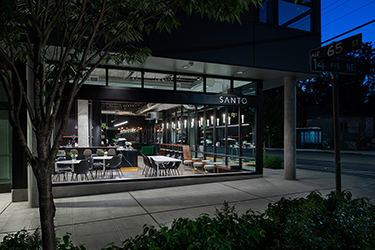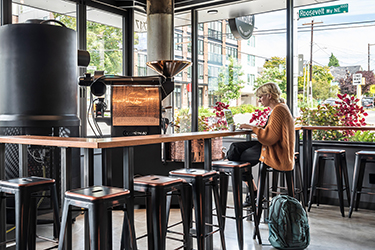|
Subscribe / Renew |
|
|
Contact Us |
|
| ► Subscribe to our Free Weekly Newsletter | |
| home | Welcome, sign in or click here to subscribe. | login |
Architecture & Engineering
| |
November 9, 2022
More than just espresso: independent coffee shops serve up elevated design
A/E Editor
Coffee is serious business around here and so is coffee shop design. A quick visit to a few independent coffee shops will reveal spaces that offer far more than a caffeine fix. Independent coffee shops are also designed to provide an experience, sometimes built solely around the coffee, but often around other elements too such as art, education, or books.
This focus on experiences has led to spaces full of unique and elevated design which local designers say makes coffee shops one of the most interesting and fun markets to work in. “In Washington, coffee is really viewed as an art-form and that is reflected in the creativity of coffee shop design here,” Wesley Pierce of Pierce Design, whose work includes the award-winning Narrative Coffee in Everett, shared with me during a recent call. “I find that clients in this space are often visionaries and better described as creative partners,” he added, “they go a cut above.”
Diversity and creativity is the name of the game when it comes to this market and you would be hard pressed to find one coffee shop that looks quite like another, even when it comes to firm's with multiple locations. Chris Parker a senior associate architect at Board & Vellum whose work in the market includes Armistice Coffee in Roosevelt and the recent re-model of three Fuel Coffee locations across Seattle (now Fuel Coffee and Books), agreed. “Each client has a different idea of what they want from the space,” he shared. “Ultimately though it's all about creating spaces that people want to be in.”
Even though no one shop is quite the same, both designers did share some key considerations and priorities that drive this market. They both emphasized the impact of Pacific Northwest coffee culture on design and how a desire to show off the latest and most innovative brewing methods and products plays into the look and feel of many spaces. “The equipment we are seeing today is very advanced and innovative,” Pierce explained, “they are often more like coffee labs than shops.”
For example, at Five Stones Coffee's Kirkland location, which opened this year, Pierce added an inverted pyramid-shaped soffit above the coffee bar and preparation station to ground the area and make state-of-the-art brewing equipment the focal point of the shop. At Armistice Coffee in Roosevelt Board & Vellum proudly displayed a working bean roaster in a section of the shop where it can be viewed from outside. Inside, work-station-type seating is placed around the roaster.
Another common thread is designing spaces that promote engagement between the product, barista and consumer. “Coffee shops should be interactive spaces,” Pierce continued. This means a lot of attention needs to be paid to the slow bar area, usually adjacent to the brewing space, which is where the consumer picks up their order. At Narrative Coffee Pierce designed a rounded coffee bar with a circular workflow around a central island that allows the baristas to maneuver gracefully around the workspace and easily interact with customers at the slow bar. It is also important to design spaces that give baristas a good and clear view of everyone in the shop, both to aid interactions and as a safety feature.
Providing a variety of seating is also key because of the often diverse mix of people that frequent an independent coffee shop, for many reasons that range from study to a date. “It's important to have a mix of small, large, semi-private and open seating options to appeal to different groups of people and how they are using the space,” Parker shared. For example, when Board & Vellum was renovating and redesigning Fuel Coffee and Books' Montlake location, in a residential area not to far from the University of Washington, the firm was sure to include seating areas that would appeal to families with plenty of seats and cozy residential-inspired fireplaces, as well as table-top seating areas perfect for those coming in to study.
Having an intuitive and effective queuing area is also important. Parker explained how this is best achieved with subtle clues, such as intentional placement of furniture, to show people where to go rather than obvious signage. Good merchandise placement is a further consideration which often includes apparel alongside bags of coffee.
“In addition to standard elements like seating, restrooms and the sales and brewing area we also want to provide spaces where the owner can insert a bit of their own, or the brands, personality,” Parker said. “A lot of our work has been about providing an attractive backdrop for the bustling activity of the shop.”
In terms of colors and materials, again no one size fits all, but it is common to find spaces with lots of wood, natural materials and colors, and greenery, as these elements are known to create a sense of calm and welcome. More muted materials and colors are often supplemented with pops of brighter color, often in rich jewel tones. For example, at Santo Coffee in Roosevelt, which was included in a contemporary cafe design book from Braun of Germany, called A Coffee A Day, Pierce designed an interior that is dominated by dark woods and stones complemented with plush emerald green furnishings. At Armistice Roosevelt wood is also a dominant material, in slightly lighter tones than at Santo, and is complemented with lots of greenery, emerald tiling at the coffee bar, and some statement lighting fixtures.
When asked, both Pierce and Parker found it difficult to pick a favorite coffee shop that they have designed, a further testament to the diversity and creativity of this market. “I think the passion and creativity that clients have is part of the reason why independent coffee shops do so well here,” Pierce concluded.
Emma Hinchliffe can be
reached by email or by phone
at (206) 622-8272.




